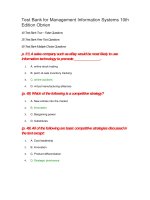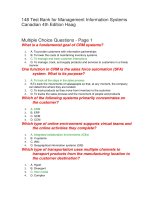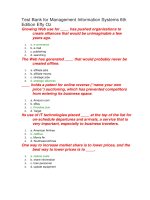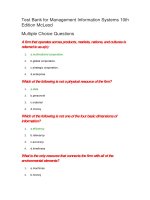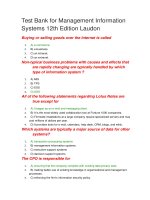Test bank for management information systems 10th edition mcleod
Bạn đang xem bản rút gọn của tài liệu. Xem và tải ngay bản đầy đủ của tài liệu tại đây (69.82 KB, 14 trang )
Test Bank for Management Information Systems 10th
Edition McLeod
Multiple Choice Questions
A firm that operates across products, markets, nations, and cultures is
referred to as a(n):
1.
a.multinational corporation.
2.
b.global corporation.
3.
c.strategic corporation.
4.
d.enterprise.
Which of the following is not a physical resource of the firm?
1.
a.data
2.
b.personnel
3.
c.material
4.
d.money
Which of the following is not one of the four basic dimensions of
information?
1.
a.efficiency
2.
b.relevancy
3.
c.accuracy
4.
d.timeliness
What is the only resource that connects the firm with all of the
environmental elements?
1.
a.machines
2.
b.money
3.
c.material
4.
d.information
What type of resource includes computer hardware and software,
information specialists, and users?
1.
a.physical resources
2.
b.information resources
3.
c.conceptual resources
4.
d.information management
Which environmental element invests money in the firm?
1.
a.customers
2.
b.financial community
3.
c.stockholders
4.
d.government
At which managerial level can managers specify how the strategic plans
will be implemented?
1.
a.strategic
2.
b.middle
3.
c.tactical
4.
d.operational
Which activity is defined as acquiring information, using it in the most
effective way, and discarding it at the proper time?
1.
a.strategic management
2.
b.tactical management
3.
c.knowledge management
4.
d.operational management
Which environmental resource flow occurs less frequently than the
others?
1.
a.information flow from customers
2.
b.material flow to customers
3.
c.money flow to stockholders
4.
d.money flow from the government
The term to describe the use of information to gain leverage in the
marketplace is:
1.
a.competitive objective.
2.
b.strategic advantage.
3.
c.competitive advantage.
4.
d.strategic objective.
When information pertains to the problem at hand, which dimension of
information is in use?
1.
a.accuracy
2.
b.timeliness
3.
c.relevancy
4.
d.completeness
Which of the following is not an advantage of coordination for the MNC?
1.
a.flexibility
2.
b.keeping abreast of market needs worldwide
3.
c.increased efficiency and effectiveness
4.
d.increased operating costs
The following are just some of the constraints that GIS developers must
address except for:
1.
a.restrictions on hardware purchases and imports.
2.
b.restrictions on graphics and icons.
3.
c.restrictions on data processing.
4.
d.restrictions on data communications.
The general systems model of a firm has the following resource flows
except for:
1.
a.geographic resource flow.
2.
b.physical resource flow.
3.
c.virtual resource flow.
4.
d.firm’s control mechanism.
The firm’s information resources consist of the following except for:
1.
a.suppliers.
2.
b.hardware.
3.
c.software.
4.
d.information specialists.
Which dimension of competitive advantage uses cookies to store
information about a user’s transactions?
1.
a.strategic
2.
b.middle
3.
c.tactical
4.
d.operational
Which of the following is not included in a SPIR?
1.
a.executive summary
2.
b.goals of the information services unit
3.
c.itemized budget
4.
d.summarized work plan
Which of the following are not environmental elements of all firms?
1.
a.suppliers
2.
b.customers
3.
c.labor unions
4.
d.materials
Which of the following is/are a support activity?
1.
a.human resources management
2.
b.marketing and sales operations
3.
c.service activities
4.
d.logistics
When a firm links its value chain to the value chains of other
organizations the linkage creates a(n):
1.
a.value system.
2.
b.interorganizational system.
3.
c.cross functional system.
4.
d.open-loop system.
Which of the following is a virtual resource of the firm?
1.
a.personnel
2.
b.material
3.
c.information
4.
d.money
The following are environmental elements except:
1.
a.suppliers.
2.
b.competitors.
3.
c.government.
4.
d.employees.
According to Porter, a firm achieves competitive advantage by:
1.
a.creating value activities.
2.
b.creating a value chain.
3.
c.creating a margin.
4.
d.creating a value system.
Which environmental element provides skilled and unskilled workers for
certain trades and industries?
1.
a.global community
2.
b.labor unions
3.
c.human resources
4.
d.personnel
Which of the following is/are not a primary value activity?
1.
a.inbound logistics
2.
b.outbound logistics
3.
c.technology development
4.
d.marketing and sales operations
Which of the following is not part of a firm’s supply chain?
1.
a.Suppliers
2.
b.Firm
3.
c.Customers
4.
d.Stockholders
The network that uses information to create competitive advantage is
called a:
1.
a.value chain.
2.
b.value network.
3.
c.value system.
4.
d.network chain.
Which of the following is concerned with obtaining such resources as
materials and machines, which are used by primary activities?
1.
a.procurement
2.
b.service activities
3.
c.marketing and sales operations
4.
d.operations
When information presents a complete picture of a problem, which
dimension of information is in use?
1.
a.relevancy
2.
b.accuracy
3.
c.timeliness
4.
d.completeness
Which environmental resource flow occurs more frequently than the
others?
1.
a.machine flow from suppliers
2.
b.material flow to suppliers
3.
c.personnel flow to competitors
4.
d.money flow from the government
True - False Questions
The CIO can position information services as a vital element in the
organizational structure of the firm by focusing on keeping business
processes as they are.
1.
True
2.
False
Communication overload suggests that harm can come from too much
information.
1.
True
2.
False
The firm exists for the purpose of making a profit.
1.
True
2.
False
The only resource that connects the firm with all of the environmental
elements is information.
1.
True
2.
False
Strategic planning for information resources is the concurrent
development of strategic plans for information services and the firm so
that the firm’s plan reflects the support to be provided by information
services.
1.
True
2.
False
Technology development supports but does influence the primary
activities of the firm.
1.
True
2.
False
Firms create value by performing value activities.
1.
True
2.
False
When a firm’s executives are fully committed to strategic planning, they
do not need each business area to develop its own strategic plan.
1.
True
2.
False
A tactical advantage is one that has a fundamental effect in shaping the
firm’s operations.
1.
True
2.
False
Management is guided in its decision making by the firm’s physical
resource flow.
1.
True
2.
False
The information resources necessary to meet the objectives are one topic
that should be included in each SPIR.
1.
True
2.
False
Information has relevancy when it pertains to the problem at hand.
1.
True
2.
False
Competitive advantage refers to the use of data to gain leverage over the
competitors.
1.
True
2.
False
The physical resources of the firm are used to produce the products and
services the firm provides to its customers.
1.
True
2.
False
Knowledge management is the process of organizing a firm’s information
so that it can easily be captured, stored, processed, and used by decision
makers.
1.
True
2.
False
The CIO is the manager of information services who contributes
managerial skills to solving problems relating not only to the information
resources but also to other areas of the firm’s operations.
1.
True
2.
False
The feedback loop is composed of the physical resources.
1.
True
2.
False
Interaction with technology can vary greatly among cultures.
1.
True
2.
False
The firm’s business partners work together to create synergy.
1.
True
2.
False
Operational advantage is one that deals with everyday transactions and
processes.
1.
True
2.
False
A global information system is an information system that consists of
networks that do not cross national boundaries.
1.
True
2.
False
The physical resources of the firm include personnel, material, machines,
and money.
1.
True
2.
False
In a larger system, the environmental elements are referred to as society.
1.
True
2.
False
A strategic advantage is one that has a fundamental effect in shaping the
firm’s products.
1.
True
2.
False
Legacy systems are incompatible or only partially compatible with current
information technology.
1.
True
2.
False
A multinational corporation is a firm that operates across products,
markets, nations, and cultures.
1.
True
2.
False
Coordinating information processing in the MNC causes the overall costs
of operation to increase.
1.
True
2.
False
The most publicized data communications restriction is that put on
transborder data flows.
1.
True
2.
False
Cookies are small files of information on the firm’s computers that store
customer information.
1.
True
2.
False
Tactical advantage is achieved when a firm implements a strategy in a
better way than its competitors.
1.
True
2.
False
Free Text Questions
What are the advantages that accrue to the MNC because of good
information processing capabilities and the ability to coordinate?
Answer Given
Flexibility in responding to competitors in different countries and markets. The
ability to respond in one country to a change in another. The ability to keep
abreast of market needs worldwide. The ability to transfer knowledge between
units in different countries. Reduction in overall operating costs. Increased
efficiency and effectiveness in meeting customer needs, and the ability to achieve
and maintain diversity in the firm’s products and in their production and
distribution.
What advice should a CIO take so he/she can position information
services as a vital element to the firm?
Answer Given
Spend time with the business so he/she can learn the business. Build partnerships
with the business units and line managers. Focus on improving business
processes. Explain IS costs in business terms. Build credibility by delivering
reliable IS services. And lastly, be open to ideas from outside the information
systems area.
Explain the four basic dimensions of information.
Answer Given
The four basic dimensions of information include relevancy, accuracy, timeliness,
and completeness. Information has relevancy when it pertains to the problem at
hand. The degree of accuracy depends on the level of accuracy needed.
Applications involving money require 100% accuracy, but long-range economic
forecasts do not need to be 100% accurate. For information to be timely, it must
be available for solving a problem before a crisis develops or before opportunities
are lost. The user should be able to obtain information that presents a complete
picture of a problem or solution, but should not be drowned in a sea of information.
What are the two core topics that should be included in every strategic
plan for information resources?
Answer Given
The two core topics that should be included in every plan: The objectives to be
achieved by each category of systems during the time period covered by the plan;
The information resources necessary to meet the objectives
Explain Porter’s strategy for firms attempting to gain a competitive
advantage.
Answer Given
A firm achieves competitive advantage by creating a value chain that consists of
primary and support activities which contribute to margin. Margin is the objective
of the chain. Firms create value by performing value activities. The primary
activities include inbound logistics, the firm’s operations, outbound logistics,
marketing and sales operations, and service activities. The firm’s support activities
include the firm’s infrastructure. Each activity contains purchased inputs, human
resources, and technology. Finally, each activity uses and creates information.





